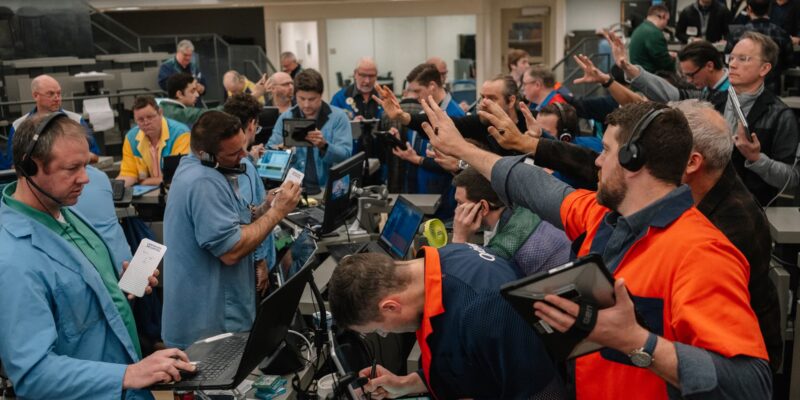
One thing uncommon is going on in a market lengthy dominated by index funds. Lively administration is staging a comeback.
Take the motion in fairness exchange-traded funds two weeks in the past. Amid extra whipsaw motion in shares that has typified 2025 buying and selling, there was a web outflow from fairness ETFs. However in a shock, the promoting was totally on the index fund aspect. There have been web outflows of $1 billion from fairness ETFs in all, however $3 billion in inflows to lively fairness ETFs to offset the $4 billion of index fund withdrawals, based on ETF Motion knowledge.
Investing eExperts say actively managed ETFs time within the highlight marks a metamorphosis that will reshape the ETF house for years to come back. A document variety of ETFs has launched this yr, with 288 new funds and the potential for over 1,000 new ETFs by year-end. In complete, there are actually greater than 2,000 lively ETFs, rivaling the whole variety of index ETFs. Whereas they solely make up about 10% of complete ETF market property, they’ve taken over one-third of the flows this yr from buyers.
By the buying and selling week ended April 25, ETFs had taken in $363 billion in flows in 2025, with $132 billion (34%) into actively run funds.
“Actively managed ETFs are taking up {the marketplace},” mentioned Jon Maier, JPMorgan Asset Administration Chief ETF Strategist, showing on final week’s “ETF Edge.”
JPMorgan gives a variety of actively managed ETFs, together with its standard revenue ETF JEPI.
There are good causes for all buyers, whether or not index or lively, to make use of ETFs. Shopping for and promote shares gives tax effectivity within the ETF wrapper, they provide all-day buying and selling liquidity, and lots of ETFs have comparatively low expense ratios. Extra lively ETFs are on the best way, with a call from the SEC anticipated that might permit firms that at the moment have conventional mutual funds to supply a model of all of these funds as an ETF.
“There may be parity between lively and passive now even when the asset bases are very a lot completely different,” Maier mentioned, referring to the truth that index funds proceed to carry the bigger share of complete property ($231 billion on this yr’s flows).
After a long time throughout which lively inventory pickers have typically been uncovered as “closet indexers” of their funds — in impact shopping for up what the index holds greater than distinguishing their portfolios from benchmarks — it is crucial for buyers to establish funds which are taking a novel method, and the way that method is structured.
Mike Akins, founding companion of ETF Motion, mentioned buyers can take a look at a measure of correlation to the general market — R-squared — as one option to get a way for a fund’s “lively” nature. Some ETF managers are working what are “lively by default” funds with a tilt, a quantitative mannequin distinctive to their agency which reinforces the underlying index efficiency, however stay nearer to the index in total composition, resembling Dimensional Fund Advisors and Advantis ETFs. Then again, companies like JPMorgan and T. Rowe Value, from the normal world of lively inventory selecting and basic inventory evaluation, are doing extra “bottoms up” analysis of shares and because of this there R2 is “a little bit decrease,” Akins mentioned.
‘Do not do something silly when the market is loopy.’
As extra money shifts into lively, it is vital for buyers to not overreact to short-term swings available in the market. Traders could have moved some huge cash earlier in April when the markets fell aside, however as of the top of final week’s buying and selling, shares had come full circle in a visit that had seen them down as a lot as 13% in April. With Friday’s surge capping the longest profitable streak for the S&P 500 in 20 years, the market had recovered all of its losses since April 2 when President Trump first introduced world tariffs, a rebound measured by returns in each the S&P and Nasdaq.
“Do not commerce round when the market panics,” mentioned Bob Pisani, CNBC Senior Markets Correspondent and “ETF Edge” host. “Do not do panic buying and selling. It is an outdated story, for 40 years been saying it, however it actually bears repeating. Do not do something silly when the market is loopy.”
Or, within the phrases of Vanguard Group founder John Bogle, the index fund pioneer: “Do not do one thing … stand there.”
As buyers select their most well-liked method to gaining market entry, historical past says crucial buying and selling technique is to stay invested, and up to date weeks make that time, with 5-7% down days adopted by a ten% up day. “If you happen to missed that day, acquired scared and offered on the 5% down day, it actually impacts returns in a long-term portfolio,” Maier mentioned. “Time available in the market, not timing the market. Typically it’s laborious and painful, however for buyers which have the wherewithal, over the long run you most likely will profit,” he added.
There’ll proceed to be causes for shift in flows away from blanket index fund publicity as macro tendencies lead the institutional aspect of the market to make use of extra lively ETFs. Funds like JEPI, which give revenue and draw back safety, or buffer ETFs that restrict the impression of inventory volatility on returns whereas capping upside, are primarily standard with registered funding advisor companies which are shopping for on behalf of many consumers for whom they handle investments. “RIAs are allocating shoppers to it,” Akins mentioned. “Everybody has agreed for some time that now we have had traditionally excessive valuations, and the market wanted a reset, so individuals took a little bit danger off” he added.
A few of that shift has occurred as a result of volatility within the bond market, which buyers have lengthy relied on for revenue, however the place motion in Treasury yields has made advisors and buyers anxious about investing in something however ultra-short time period bonds (roughly 60% of all bond ETF flows this yr). “They discovered a special option to allocate fastened revenue cash to related beta, or up and downs available in the market, and seize that aspect of the market, however in a means that may meet revenue wants and acquire some return from the general equities market,” Akins mentioned.
The place battle between index funds and lively is headed
The rise of the youthful retail investor can also be an necessary a part of the lively phenomenon.
Robinhood CFO Jason Warnick mentioned on its earnings name final week that the brokerage app noticed “extremely sturdy engagement throughout the board,” by means of the primary quarter and in April. “When the market is down, our clients are typically web shopping for on the day. Just a few years in the past, of us had been frightened about what’s going to occur to the retail dealer if the market softens? This quarter and the energy of April actually helps to reply a few of these questions.”
That comes with some outsize lively buying and selling danger, although, based on Akins, with the youthful era of “YOLO” buyers actually leaning into leverage and inverse ETF methods. With $10 billion in inflows yr up to now, leveraged and inverse ETFs investing in a single inventory like Tesla or Nvidia typify this development.
“All of the proof says this isn’t institutional cash. Lower than 5% of those ETFs are held by establishments primarily based on 13F filings. It’s being pushed by retail,” Akins mentioned. “On the leverage ETF aspect, there are simply increasingly more individuals embracing the inventory market and extra ‘Robinhood’ merchants are prepared to do some loopy stuff.”
Maier says there can be extra of a gradual transfer into lively ETFs in additional conventional asset courses, resembling large-cap worth and progress, and worldwide, because the ETF construction turns into extra accepted.
Akins expects any cut up available in the market to nonetheless lean heavy on index funds inside conventional investing methods, with passive funds taking 80%-90% of property total. However the tendencies of the previous few years, from the risk-on single-stock funds to the brand new revenue and draw back safety methods, will develop.
“We’ll proceed to see the spicy aspect of the market develop increasingly more, leverage and inverse. Each weekend, after I sit right down to overview new launches, I simply shake my head on the only inventory aspect. However we are going to see extra innovation on artificial revenue and buffered methods … a continuation of the large themes we have been seeing,” he mentioned.
Join for our weekly e-newsletter that goes past the livestream, providing a better take a look at the tendencies and figures shaping the ETF market.










